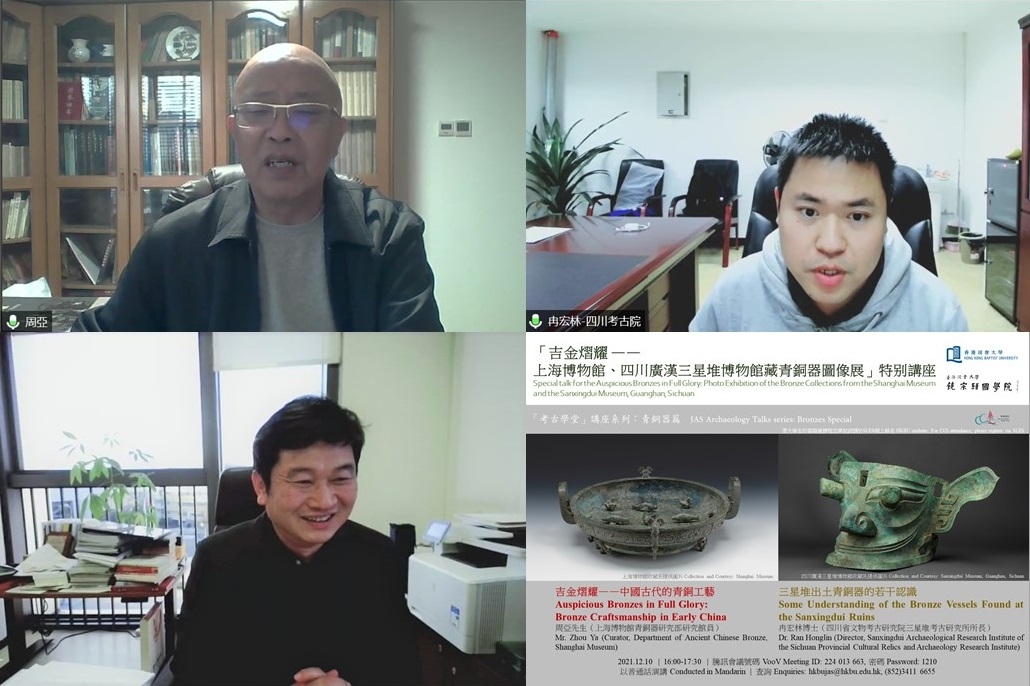The essence of archaeology is to reconstruct the ancient ways of life from the perspective of material culture. As we know, Sinology is a far broader discipline than textual studies, but beneath it all lies a curiosity and imagination to human conditions in the past. The Academy therefore launched the new “Archaeology Seminar Series” in 2018 to expand its research profile in the direction of Chinese Archaeology. We are currently curating a series of talks on major archaeological discoveries in recent decades, such as the archaeology of Early China, the splendid Bronze Age culture of Sanxingdui, excavated manuscripts of the Qin and Han periods, the Zoumalou official documents and records of the Three Kingdoms period, and gold and silver wares of the Tang dynasty, making this expert knowledge accessible to the public.
As a special talk for the
"Auspicious Bronzes in Full Glory: Photo Exhibition of the Bronze Collections from the Shanghai Museum and the Sanxingdui Museum, Guanghan, Sichuan" held from this October to December, the Jao Tsung-I Academy of Sinology (JAS) invited archaeological experts to give online talks on professional knowledge and archaeological findings on bronze vessels, for the
JAS Archaeology Talks series: Bronzes Special. Event details are as follows:
Date: 10 December 2021, Friday
Time: 4:00-5:30pm
Online Platform: VooV Meeting
Language: Mandarin
Moderator: Prof. Chen Zhi (Director, HKBU Jao Tsung-I Academy of Sinology)
Auspicious Bronzes in Full Glory: Bronze Craftsmanship in Early China
Speaker: Mr. Zhou Ya (Curator, Department of Ancient Chinese Bronze, Shanghai Museum)
Some Understanding of the Bronze Vessels Found at the Sanxingdui Ruins
Speaker: Dr. Ran Honglin (Director, Sanxingdui Archaeological Research Institute of the Sichuan Provincial Cultural Relics and Archaeology Research Institute)
Summary (Recorded by Guo Qianmeng):
周亞先生以上海博物館所藏各類青銅器為例,自器型、紋飾、銘文及其製造工藝在各個階段的主要特徵,對青銅工藝發展史脈絡進行了分期梳理。「萌生期」的青銅工藝以處於夏晚期的河南偃師二里頭遺址中出土的青銅造器為例。而「育成期」的青銅工藝包括了在黃河、長江中游地區發現的商代早、中期的容器和兵器。青銅工藝在商晚期達到其「鼎盛期」,並一直延續至西周早期,該時期器型齊全,造型日臻完善,且其紋飾空前發達。而自西周中期延續至春秋早期,青銅工藝到達了其「轉變期」。其主要特徵是前期從鼎盛期的豪華精麗轉向端莊厚重,後期則缺乏創新,呈現出程式化的傾向。春秋中期以後,青銅工藝達到了其「更新期」,各地域新的器型出現,式樣富於變化,銘文各具風貌。
冉宏林博士則以四川廣漢三星堆遺址出土的部分青銅器為例對其考古背景信息展開探討。首先冉博士據1987年挖掘土坑形製、坑內殘留燒骨碴和灰燼及其出土文物擺放位置等判斷倉包包為一祭祀坑。再通過倉包包城墻的解剖、其中出土陶器及其測年結果,將倉包包祭祀坑形成年代及坑內銅器埋葬年代判定為商代中期。隨後冉博士個案分析了三星堆中造型奇特的青銅器,如扭頭跪坐銅人像、人頭像、頂尊跪坐銅人像等。主要可以分為有源自中原地區和長江中下游地區的容器類銅器,以及以人物形象居多的造型銅器兩大類。最後冉博士對這些銅器的考古背景進行了考察,通過碳十四測年、出土文物埋藏方式、擺放位置、與其他器物的共存關係,以及在遺址中的分佈情況判定,三星堆幾大坑的年代基本是同時的,但五號、六號坑與其他坑明顯不同。
Lecture video: Thanks to the two speakers' authorization, please
click here to watch the recording.
